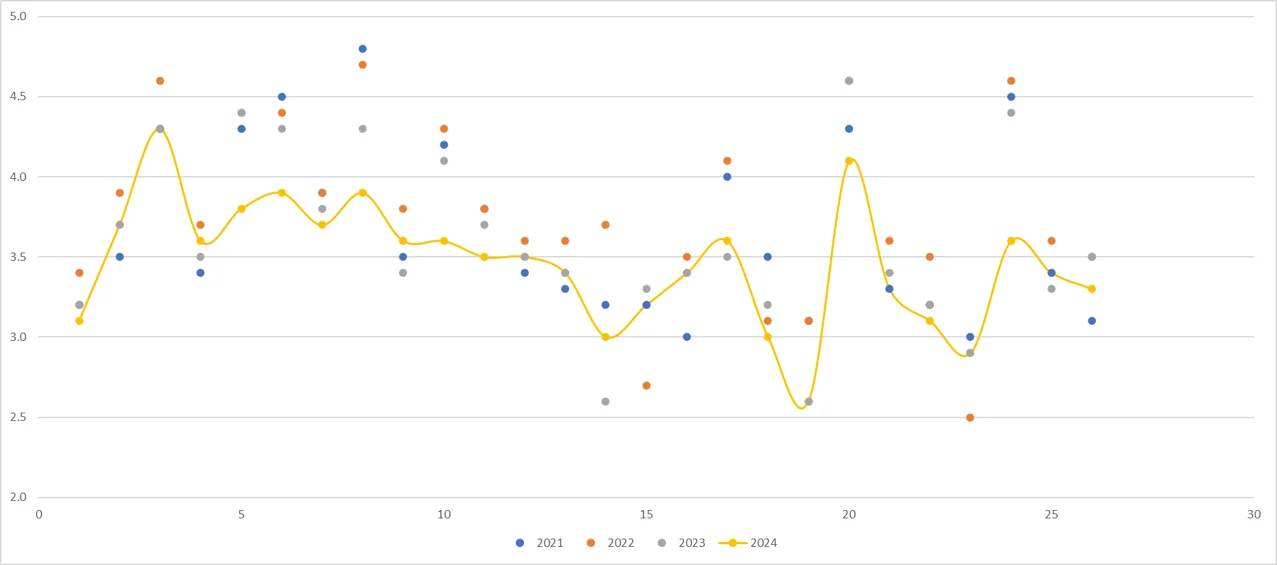
Exploring healthcare star ratings is like figuring out a puzzle that keeps changing. It’s about understanding the small details that affect how well healthcare organizations can keep their ratings high.
These ratings, which measure Medicare Advantage (Part C) and prescription drug (Part D) plans, use a simple 5-star scale – 1 being the lowest and 5 the highest. They serve to broadly guide people on how good a health plan is based on how happy people are with it and the quality of care it gives.
In a previous blog, Medicare Star Ratings Explained and Their Financial Impact, we talked more about the finanical implications of star ratings. In this blog, we’ll look closely at the challenges healthcare organizations face in keeping their star ratings high.
Positive experiences with staff and a good healthcare journey are key to getting higher ratings. This highlights the need for healthcare providers to adapt their strategies to keep up with these changes.
Top Challenges for Healthcare Payers
Several challenges persist for providers aiming to keep their ratings high.
- The top challenges include:
- Changing Cut Points
- Multiple Areas of Focus
- External Factors
Changing Cut Points
The first challenge in this process is when CMS (Centers for Medicare & Medicaid Services) makes changes to the cut points every year. Cut points are the score ranges that determine the assignment of stars on a specific measure. Essentially, they set the bar for what qualifies as a 1-star, 2-star, 3-star, 4-star, or 5-star rating.
These changes can really shake up healthcare organizations, affecting how many stars they get. Watching how these cut points go up and down helps us see the tough road healthcare organizations travel to keep up with changes.
It’s important to mention that having a dependable partner to keep an eye on this trend data can really help when planning for next year’s ratings.
Relevant News
Elevance nabs $190M in Medicare Advantage star ratings revision(Modern Healthcare, March 5, 2024)
In 2023, CMS took decisive actions to strengthen star ratings criteria following a surge in scores, leading to a reduction in the number of Medicare Advantage plans eligible for bonuses. Elevance Health and its regional affiliates filed a lawsuit against the federal government in December 2023, urging CMS to reverse technical adjustments to the star ratings system, recalculate scores, and reassess quality bonus payments.
In a significant development in March 2024, CMS agreed to reevaluate Elevance’s contract ratings, resulting in an additional $190 million bonus payout for the organization.
Multiple Areas of Focus
Earning top-notch star ratings isn’t a one-size-fits-all task. It’s like juggling different balls at once, trying to balance various aspects.
Let’s look at this challenge by exploring the different areas healthcare organizations need to manage for excellent star ratings:
|
|
|
|

|
| Patient Satisfaction | Clinical Quality | Operational Efficiency | Safety Measures | Accessibility and Timeliness |
Patient Satisfaction
Ensuring patients are content with their healthcare experiences is crucial, covering communication, care, and overall satisfaction. Hospitals improve communication to ensure patients feel heard and cared for.
Clinical Quality
Providing top-notch clinical services is essential, including accurate diagnoses, effective treatments, and meeting strict standards. Clinics train staff and use proven practices for better overall clinical quality, consisting of various sub measures.
Operational Efficiency
Behind the scenes, efficient operations matter, involving simplified paperwork, reduced wait times, and wise resource use for overall success. Medical facilities use technology to make administrative tasks easier, boosting efficiency and star ratings.
Safety Measures
Keeping patients and staff safe is a top priority, involving the prevention of errors, infections, and safety concerns. Hospitals adhere to strict safety protocols, such as hand hygiene and error prevention, to enhance safety and star ratings.
Accessibility and Timeliness
Providing timely access to care is crucial for patient satisfaction, minimizing wait times and ensuring convenient appointments. Clinics implement better scheduling methods to reduce wait times, facilitating easier access to care when needed.
Through these examples and straightforward insights, we’ll uncover the challenge healthcare organizations face in trying to excel across various areas, emphasizing the diverse nature of maintaining star ratings.
Trend Analysis: Year-to-Year Changes in Star Ratings
Taking a step back, let’s examine the broader picture of year-to-year changes in healthcare star ratings.The graphics illustrate star rating fluctuations from 2021 to 2024, providing a visual representation of the trends in average star ratings for Part C measure and for MA-PDs (Medicare Advantage Prescription Drug Plans).
These trends suggest a dynamic environment where the quality of healthcare plans experiences variations over the years.
2021 – 2024 Average Star Rating by Part C Measure

Source: CMS Medicare Advantage Fact Sheet, 2024.
Part C measures include assessments related to health screenings, disease management, and care for specific populations. Notable observations include:
- Improvements in Breast Cancer and Colorectal Cancer Screening ratings over the years
- Monitoring Physical Activity and Osteoporosis Management in Women who had a Fracture show declines
- Measures such as Care for Older Adults – Medication Review and Diabetes Care – Blood Sugar Controlled depict fluctuations
MA-PD’s average star ratings display shifts from year to year. These fluctuations could be influenced by changes in healthcare practices, improvements in service delivery, or adjustments to CMS criteria.Analyzing these trends allows us to pinpoint specific areas that healthcare organizations may need to focus on for consistent improvement.
By identifying and comprehending these trends, healthcare organizations can proactively address challenges, implement targeted improvements, and strive for a more consistent and higher-quality healthcare delivery.
External Factors Impacting Star Ratings
Beyond the direct influence of healthcare organizations, several external factors contribute significantly to the shaping of star ratings. These factors extend beyond the internal workings of a healthcare facility and often play a crucial role in determining the overall rating.
Specific examples of external factors impacting star ratings include:
| Demographic Shifts | Regulatory Changes | Economic Factors | Technological Advances | Public Health Events |
Demographic Shifts
Changes in the population’s makeup, such as age, ethnicity, or socio-economic status, can influence healthcare utilization patterns and perceptions of care quality. However, it’s worth considering whether these changes occur significantly for any plan area within a year or two. For instance, an aging population might drive increased demand for specific healthcare services, impacting overall satisfaction levels and, consequently, star ratings.
Regulatory Changes
Alterations in healthcare regulations and policies at local, state, or national levels can introduce new standards or modify existing ones, influencing how healthcare organizations are assessed. The implementation of new patient safety regulations may require adjustments in healthcare practices, affecting both clinical quality measures and overall star ratings.
Economic Factors
Economic fluctuations, such as recessions or periods of prosperity, can impact healthcare funding, resource allocation, and, subsequently, the ability of organizations to deliver high-quality care. During economic downturns, healthcare organizations may face budget constraints, affecting staffing levels and potentially influencing patient satisfaction scores.
Technological Advances
Rapid advancements in healthcare technology can impact the perception of care quality and patient experience, potentially affecting star ratings. The implementation of a new electronic health record system might initially disrupt workflows, influencing the patient experience and reflecting in star ratings.
Public Health Events
Unforeseen public health events, such as pandemics or disease outbreaks, can significantly impact healthcare organizations’ ability to maintain high-quality services and, consequently, affect their star ratings. The COVID-19 pandemic led to changes in healthcare delivery, resource allocation, and patient perceptions, all of which could influence star ratings.
By exploring these external factors and providing credible references, we aim to offer readers a comprehensive understanding of the broader influences that contribute to the intricate world of healthcare star ratings.
Transforming Challenges into Opportunities for Star Ratings With Genzeon
It’s crucial to underscore that adaptability is key to overcoming these challenges successfully.Genzeon is a recognized leader specializing in Medicare Analytics solutions. Our expertise lies at the intersection of technology and healthcare, delivering tailored solutions that redefine industry standards. We focus on precision and excellence to ensure that clients receive top-notch services, making Genzeon the trusted ally for navigating the complexities of healthcare data analytics.
Our expertise lies at the intersection of technology and healthcare, delivering tailored solutions that redefine industry standards. We focus on precision and excellence to ensure that clients receive top-notch services, making Genzeon the trusted ally for navigating the complexities of healthcare data analytics.
Explore Genzeon’s Medicare Analytics page for helpful insights and progress and see how technology can transform your organization for lasting success in the changing worlds of healthcare and retail.
Initiate your journey towards improvement by contacting Genzeon today.


